Acute Lung Functional and Airway Remodeling Effects of an Inhaled Highly Selective Phosphodiesterase 4 Inhibitor in Ventilated Preterm Lambs Exposed to Chorioamnionitis
Abstract
1. Introduction
2. Results
2.1. Effect of PDE4 Inhibition on Lung Function Parameters
2.2. Effect of PDE4 Inhibition on Static Lung Compliance and Lung Water Content
2.3. Effect of PDE4 Inhibition on Lung Structure
2.4. Effect of PDE4 Inhibition on Elastin Deposition
2.5. Effect of PDE4 Inhibition on TGF-β Signalling
3. Discussion
4. Materials and Methods
4.1. Animal Study
4.2. Microscopic Analysis
4.3. Stereological Analysis
4.4. Elastin
4.5. RNA Extraction and Real-Time PCR
4.6. Statistical Analysis
Author Contributions
Funding
Institutional Review Board Statement
Informed Consent Statement
Data Availability Statement
Acknowledgments
Conflicts of Interest
References
- Hutten, M.C.; Kramer, B.W. Patterns and etiology of acute and chronic lung injury: Insights from experimental evidence. Chin. J. Contemp. Pediatr. 2014, 16, 448–459. [Google Scholar]
- Speer, C.P. Chorioamnionitis, postnatal factors and proinflammatory response in the pathogenetic sequence of bronchopulmonary dysplasia. Neonatology 2009, 95, 353–361. [Google Scholar] [CrossRef] [PubMed]
- Hutten, M.C.; Wolfs, T.G.; Kramer, B.W. Can the preterm lung recover from perinatal stress? Mol. Cell. Pediatr. 2016, 3, 15. [Google Scholar] [CrossRef] [PubMed]
- Mokra, D.; Mokry, J.; Matasova, K. Phosphodiesterase inhibitors: Potential role in the respiratory distress of neonates. Pediatr. Pulmonol. 2018, 53, 1318–1325. [Google Scholar] [CrossRef] [PubMed]
- Schmidt, B.; Roberts, R.S.; Davis, P.; Doyle, L.W.; Barrington, K.J.; Ohlsson, A.; Solimano, A.; Tin, W. Caffeine therapy for apnea of prematurity. N. Engl. J. Med. 2006, 354, 2112–2121. [Google Scholar] [CrossRef] [PubMed]
- Kroegel, C.; Foerster, M. Phosphodiesterase-4 inhibitors as a novel approach for the treatment of respiratory disease: Cilomilast. Expert Opin. Investig. Drugs 2007, 16, 109–124. [Google Scholar] [CrossRef] [PubMed]
- Luo, J.; Yang, L.; Yang, J.; Yang, D.; Liu, B.-C.; Liu, D.; Liang, B.-M.; Liu, C.-T. Efficacy and safety of phosphodiesterase 4 inhibitors in patients with asthma: A systematic review and meta-analysis. Respirology 2018, 23, 467–477. [Google Scholar] [CrossRef]
- Chong, J.; Leung, B.; Poole, P. Phosphodiesterase 4 inhibitors for chronic obstructive pulmonary disease. Cochrane Database Syst. Rev. 2017, 9, CD002309. [Google Scholar] [CrossRef]
- Kawamatawong, T. Phosphodiesterase-4 Inhibitors for Non-COPD Respiratory Diseases. Front. Pharmacol. 2021, 12, 518345. [Google Scholar] [CrossRef]
- de Visser, Y.P.; Walther, F.J.; Laghmani, E.H.; van Wijngaarden, S.; Nieuwland, K.; Wagenaar, G.T.M. Phosphodiesterase-4 inhibition attenuates pulmonary inflammation in neonatal lung injury. Eur. Respir. J. 2008, 31, 633–644. [Google Scholar] [CrossRef]
- Mokra, D.; Drgova, A.; Pullmann, R.; Calkovska, A. Selective phosphodiesterase 3 inhibitor olprinone attenuates meconium-induced oxidative lung injury. Pulm. Pharmacol. Ther. 2012, 25, 216–222. [Google Scholar] [CrossRef] [PubMed]
- Mokra, D.; Tonhajzerova, I.; Pistekova, H.; Visnovcova, Z.; Mokry, J.; Drgova, A.; Repcakova, M.; Calkovska, A. Short-term cardiovascular effects of selective phosphodiesterase 3 inhibitor olprinone versus non-selective phosphodiesterase inhibitor aminophylline in a meconium-induced acute lung injury. J. Physiol. Pharmacol. 2013, 64, 751–759. [Google Scholar] [PubMed]
- Kosutova, P.; Mikolka, P.; Kolomaznik, M.; Rezakova, S.; Calkovska, A.; Mokra, D. Effects of roflumilast, a phosphodiesterase-4 inhibitor, on the lung functions in a saline lavage-induced model of acute lung injury. Physiol. Res. 2017, 66 (Suppl. 2), S237–S245. [Google Scholar] [CrossRef] [PubMed]
- Yang, D.; Yang, Y.; Zhao, Y. Ibudilast, a Phosphodiesterase-4 Inhibitor, Ameliorates Acute Respiratory Distress Syndrome in Neonatal Mice by Alleviating Inflammation and Apoptosis. Med. Sci. Monit. 2020, 26, e922281. [Google Scholar] [CrossRef] [PubMed]
- Häfner, D.; Germann, G. Additive Effects of Phosphodiesterase-4 Inhibition on Effects of rSP-C Surfactant. Am. J. Respir. Crit. Care Med. 2000, 161, 1495–1500. [Google Scholar] [CrossRef]
- Kosutova, P.; Mikolka, P.; Balentova, S.; Kolomaznik, M.; Adamkov, M.; Mokry, J.; Calkovska, A.; Mokra, D. Effects of phosphodiesterase 5 inhibitor sildenafil on the respiratory parameters, inflammation and apoptosis in a saline lavage-induced model of acute lung injury. J. Physiol. Pharmacol. 2018, 69, 815–826. [Google Scholar] [CrossRef]
- Turhan, A.H.; Atıcı, A.; Muslu, N.; Polat, A.; Helvacı, I. The effects of pentoxifylline on lung inflammation in a rat model of meconium aspiration syndrome. Exp. Lung Res. 2012, 38, 250–255. [Google Scholar] [CrossRef]
- Chen, W.; Lin, C.; Lee, Y.; Tsao, P.; Jeng, M. Pathophysiological effects of intravenous phosphodiesterase type 4 inhibitor in addition to surfactant lavage in meconium-injured newborn piglet lungs. Pediatr. Pulmonol. 2020, 55, 2272–2282. [Google Scholar] [CrossRef]
- Fehrholz, M.; Speer, C.P.; Kunzmann, S. Caffeine and rolipram affect Smad signalling and TGF-beta1 stimulated CTGF and transgelin expression in lung epithelial cells. PLoS ONE 2014, 9, e97357. [Google Scholar] [CrossRef]
- De Visser, Y.P.; Walther, F.J.; Laghmani, E.H.; Steendijk, P.; Middeldorp, M.; Van Der Laarse, A.; Wagenaar, G.T.M. Phosphodiesterase 4 inhibition attenuates persistent heart and lung injury by neonatal hyperoxia in rats. Am. J. Physiol. Lung Cell. Mol. Physiol. 2012, 302, L56–L67. [Google Scholar] [CrossRef]
- Woyda, K.; Koebrich, S.; Reiss, I.; Rudloff, S.; Pullamsetti, S.S.; Ruhlmann, A.; Weissmann, N.; Ghofrani, A.; Gunther, A.; Seeger, W.; et al. Inhibition of phosphodiesterase 4 enhances lung alveolarisation in neonatal mice exposed to hyperoxia. Eur. Respir. J. 2009, 33, 861–870. [Google Scholar] [CrossRef] [PubMed]
- Méhats, C.; Franco-Montoya, M.-L.; Boucherat, O.; Lopez, E.; Schmitz, T.; Zana, E.; Evain-Brion, D.; Bourbon, J.; Delacourt, C.; Jarreau, P.-H. Effects of phosphodiesterase 4 inhibition on alveolarization and hyperoxia toxicity in newborn rats. PLoS ONE 2008, 3, e3445. [Google Scholar] [CrossRef] [PubMed]
- Hilgendorff, A.; Reiss, I.; Ehrhardt, H.; Eickelberg, O.; Alvira, C.M. Chronic lung disease in the preterm infant. Lessons learned from animal models. Am. J. Respir. Cell Mol. Biol. 2014, 50, 233–245. [Google Scholar] [CrossRef] [PubMed]
- Pringle, K.C. Human fetal lung development and related animal models. Clin. Obstet. Gynecol. 1986, 29, 502–513. [Google Scholar] [CrossRef] [PubMed]
- Wolfs, T.G.; Jellema, R.K.; Turrisi, G.; Becucci, E.; Buonocore, G.; Kramer, B.W. Inflammation-induced immune suppression of the fetus: A potential link between chorioamnionitis and postnatal early onset sepsis. J. Matern. Neonatal Med. 2012, 25 (Suppl. 1), 8–11. [Google Scholar] [CrossRef]
- Hütten, M.C.; Fehrholz, M.; Konrad, F.M.; Ophelders, D.; Kleintjes, C.; Ottensmeier, B.; Spiller, O.B.; Glaser, K.; Kramer, B.W.; Kunzmann, S. Detrimental Effects of an Inhaled Phosphodiesterase-4 Inhibitor on Lung Inflammation in Ventilated Preterm Lambs Exposed to Chorioamnionitis Are Dose Dependent. J. Aerosol Med. Pulm. Drug Deliv. 2019, 32, 396–404. [Google Scholar] [CrossRef]
- Phillips, J.E. Inhaled Phosphodiesterase 4 (PDE4) Inhibitors for Inflammatory Respiratory Diseases. Front. Pharmacol. 2020, 11, 259. [Google Scholar] [CrossRef]
- Crowley, G.; Kwon, S.; Caraher, E.J.; Haider, S.H.; Lam, R.; Batra, P.; Melles, D.; Liu, M.; Nolan, A. Quantitative lung morphology: Semi-automated measurement of mean linear intercept. BMC Pulm. Med. 2019, 19, 206. [Google Scholar] [CrossRef]
- Hsia, C.C.W.; Hyde, D.M.; Ochs, M.; Weibel, E.R.; on behalf of the ATS/ERS Joint Task Force on the Quantitative Assessment of Lung Structure. An Official Research Policy Statement of the American Thoracic Society/European Respiratory Society: Standards for Quantitative Assessment of Lung Structure. Am. J. Respir. Crit. Care Med. 2010, 181, 394–418. [Google Scholar] [CrossRef]
- Schneider, J.P.; Ochs, M. Stereology of the Lung. In Methods in Cell Biology; Laboratory Methods in Cell Biology: Imaging; Conn, P.M., Ed.; Academic Press: Oxford, UK, 2013; Chapter 12; Volume 113, pp. 257–294. [Google Scholar]
- Scherle, W. A Simple Method for Volumetry of Organs in Quantitative Stereology. Mikroskopie 1970, 26, 53–60. [Google Scholar]
- Michel, R.P.; Cruz-Orive, L.M. Application of the Cavalieri principle and Vertical Sections Method to Lung: Estimation of Volume and Pleural Surface Area. J. Microsc. 1988, 150, 117–136. [Google Scholar] [CrossRef] [PubMed]
- Burri, P.H. Structural aspects of postnatal lung development—Alveolar formation and growth. Biol. Neonate 2006, 89, 313–322. [Google Scholar] [CrossRef]
- Collins, J.J.P.; Kallapur, S.G.; Knox, C.L.; Nitsos, I.; Polglase, G.R.; Pillow, J.J.; Kuypers, E.; Newnham, J.P.; Jobe, A.H.; Kramer, B.W. Inflammation in fetal sheep from intra-amniotic injection of Ureaplasma parvum. Am. J. Physiol. Lung Cell. Mol. Physiol. 2010, 299, L852–L860. [Google Scholar] [CrossRef] [PubMed]
- Collins, J.J.P.; Kunzmann, S.; Kuypers, E.; Kemp, M.W.; Speer, C.P.; Newnham, J.P.; Kallapur, S.G.; Jobe, A.H.; Kramer, B.W. Antenatal glucocorticoids counteract LPS changes in TGF-beta pathway and caveolin-1 in ovine fetal lung. Am. J. Physiol. Lung Cell. Mol. Physiol. 2013, 304, L438–L444. [Google Scholar] [CrossRef] [PubMed]
- Kunzmann, S.; Speer, C.P.; Jobe, A.H.; Kramer, B.W. Antenatal inflammation induced TGF-beta1 but suppressed CTGF in preterm lungs. Am. J. Physiol. Lung Cell. Mol. Physiol. 2007, 292, L223–L231. [Google Scholar] [CrossRef]
- Been, J.V.; Zimmermann, L.J. Histological chorioamnionitis and respiratory outcome in preterm infants. Archives of disease in childhood. Fetal Neonatal Ed. 2009, 94, F218–F225. [Google Scholar] [CrossRef]
- Hütten, M.C.; Kuypers, E.; Ophelders, D.R.; Nikiforou, M.; Jellema, R.K.; Niemarkt, H.J.; Fuchs, C.; Tservistas, M.; Razetti, R.; Bianco, F.; et al. Nebulization of Poractant alfa via a vibrating membrane nebulizer in spontaneously breathing preterm lambs with binasal continuous positive pressure ventilation. Pediatr. Res. 2015, 78, 664–669. [Google Scholar] [CrossRef]
- Schneider, J.P.; Ochs, M. Alterations of Mouse Lung Tissue Dimensions during Processing for Morphometry: A Comparison of Methods. Am. J. Physiol. Cell. Mol. Physiol. 2014, 306, L341–L350. [Google Scholar] [CrossRef]
- Mayhew, T.M. Taking Tissue Samples from the Placenta: An Illustration of Principles and Strategies. Placenta 2008, 29, 1–14. [Google Scholar] [CrossRef]
- Schindelin, J.; Arganda-Carreras, I.; Frise, E.; Kaynig, V.; Longair, M.; Pietzsch, T.; Preibisch, S.; Rueden, C.; Saalfeld, S.; Schmid, B.; et al. Fiji: An Open-Source Platform for Biological-Image Analysis. Nat. Methods 2012, 9, 676–682. [Google Scholar] [CrossRef]
- Tschanz, S.; Burri, P.; Weibel, E. A Simple Tool for Stereological Assessment of Digital Images: The STEPanizer. J. Microsc. 2011, 243, 47–59. [Google Scholar] [CrossRef] [PubMed]
- Schneider, J.P.; Arkenau, M.; Knudsen, L.; Wedekind, D.; Ochs, M. Lung Remodeling in Aging Surfactant Protein D Deficient Mice. Ann. Anat.-Anat. Anz. 2017, 211, 158–175. [Google Scholar] [CrossRef] [PubMed]
- Livak, K.J.; Schmittgen, T.D. Analysis of relative gene expression data using real-time quantitative PCR and the 2(-Delta Delta C(T)) Method. Methods 2001, 25, 402–408. [Google Scholar] [CrossRef] [PubMed]
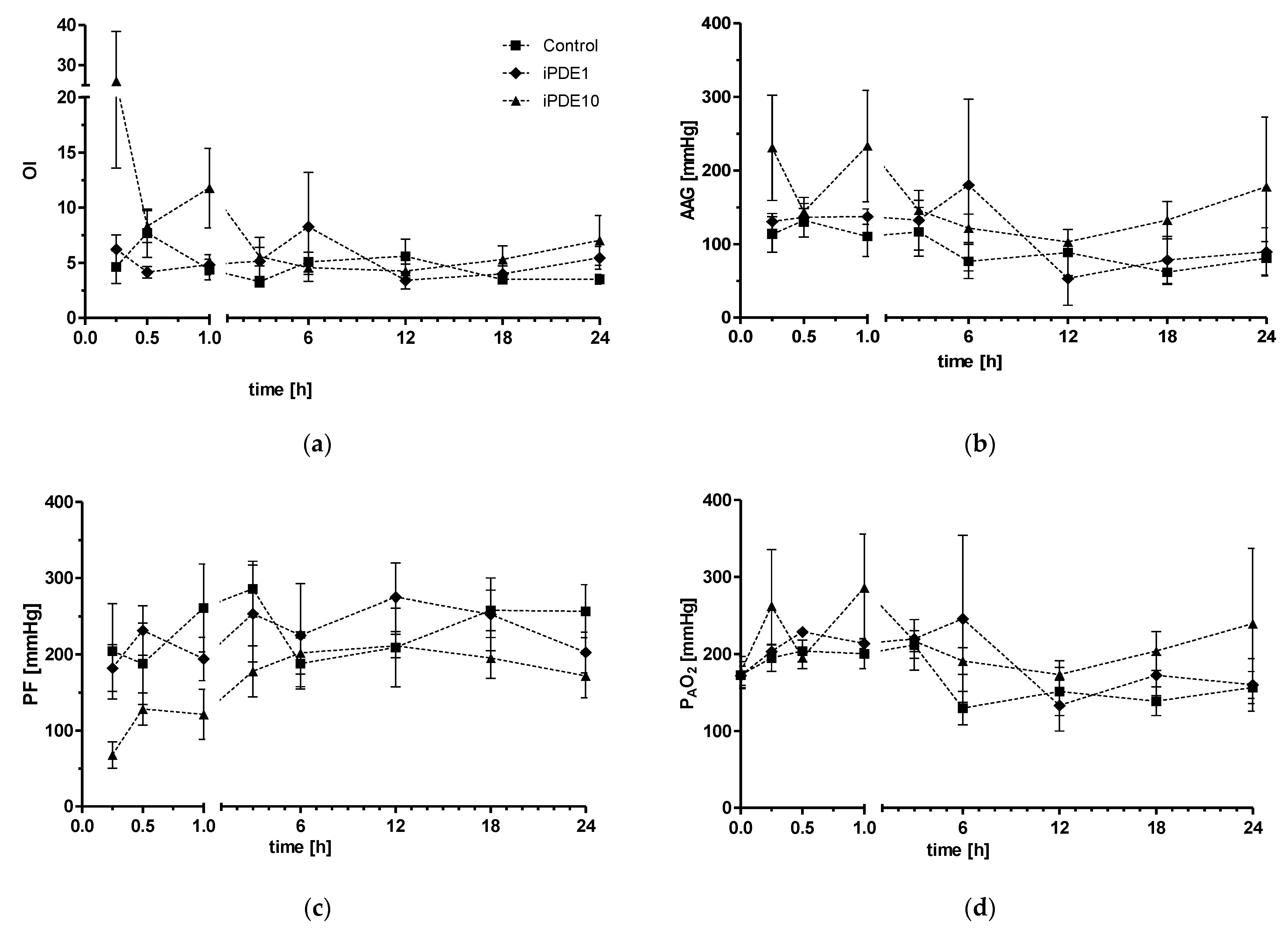
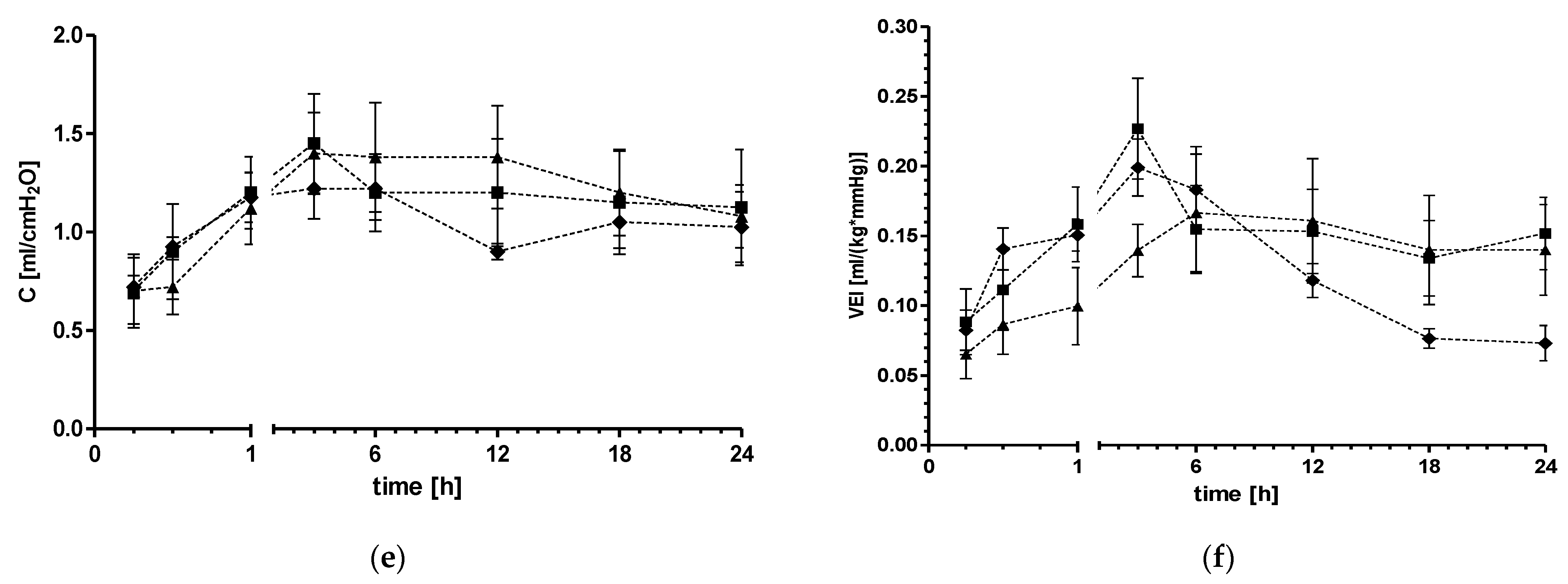
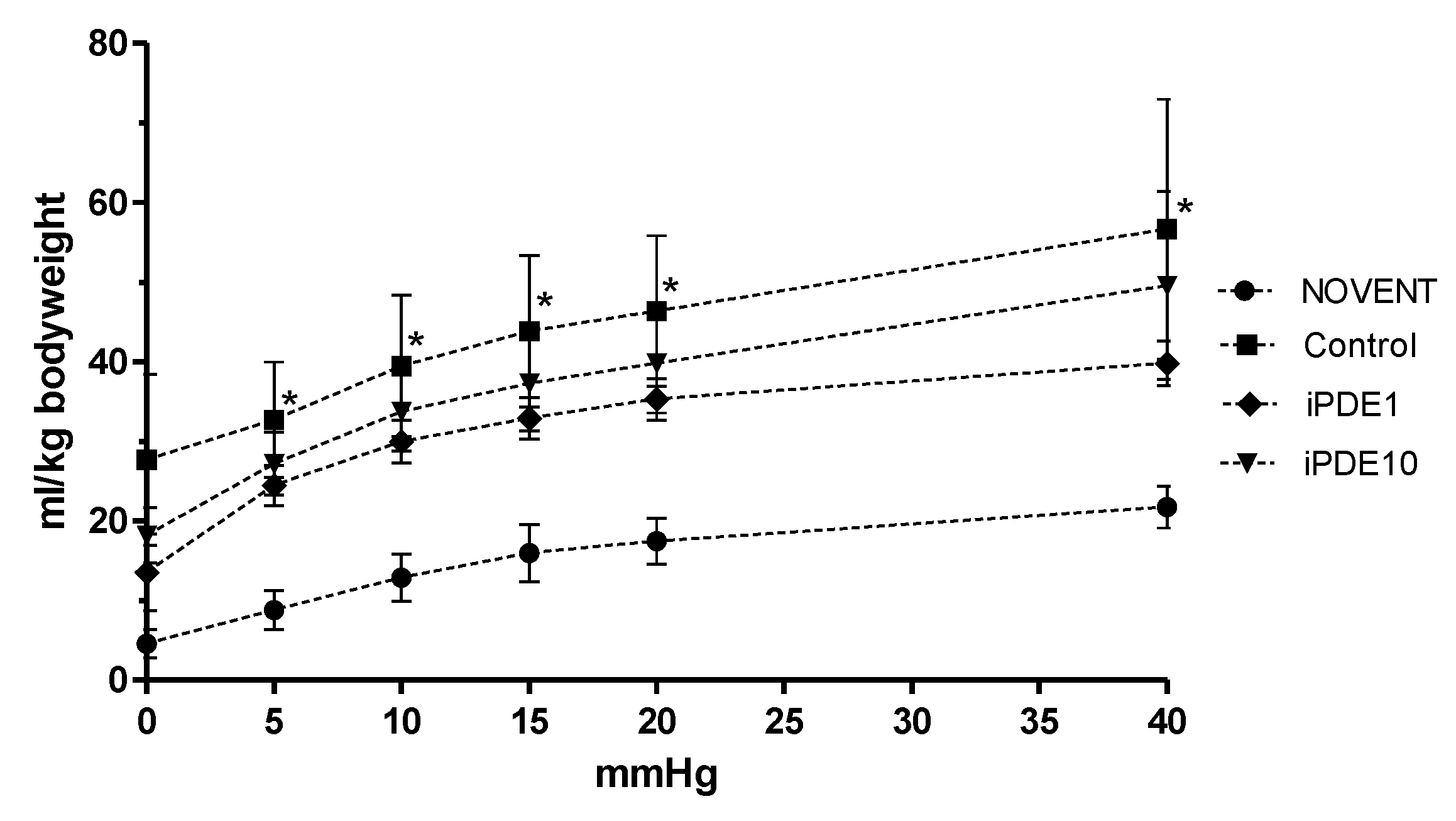
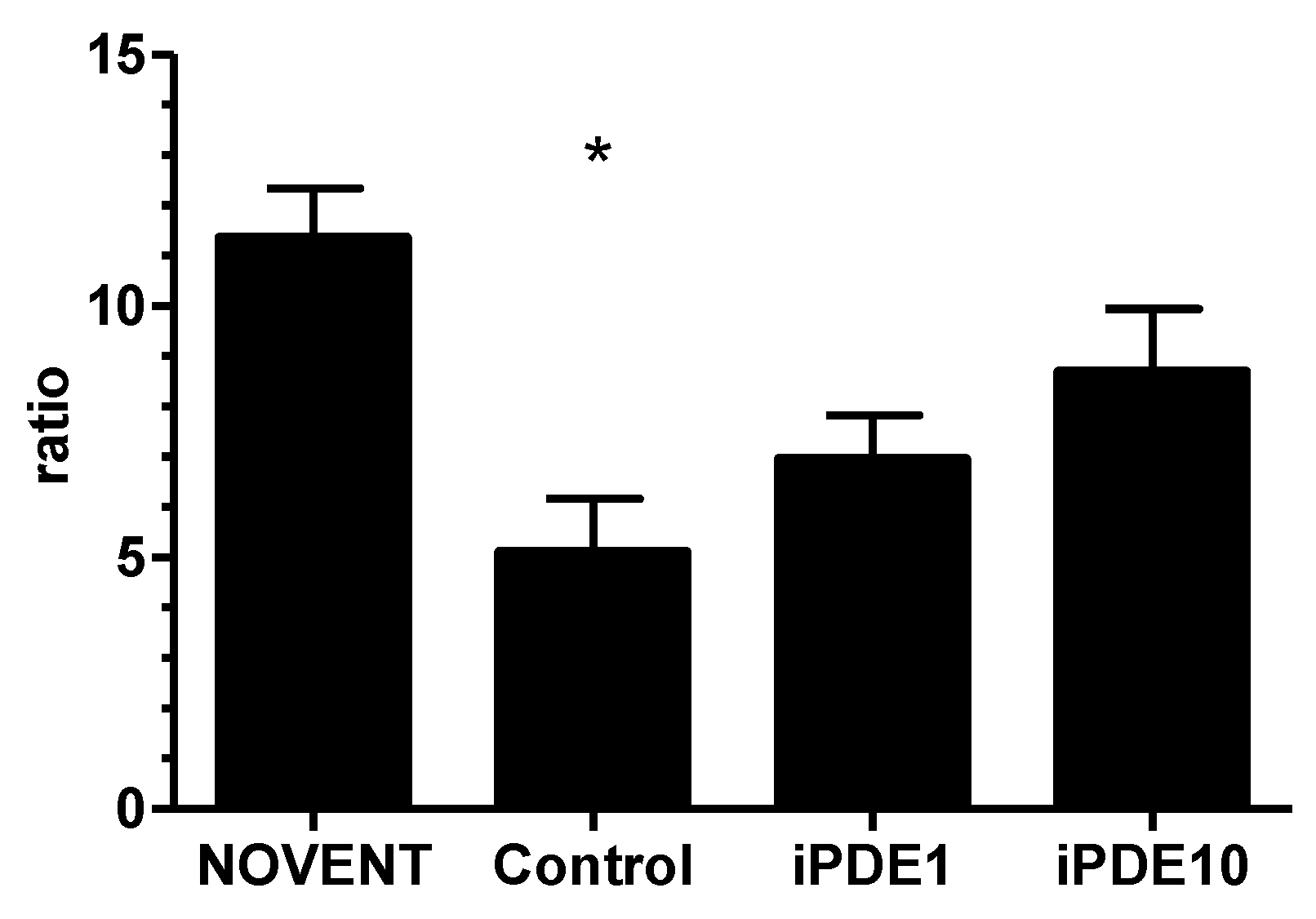
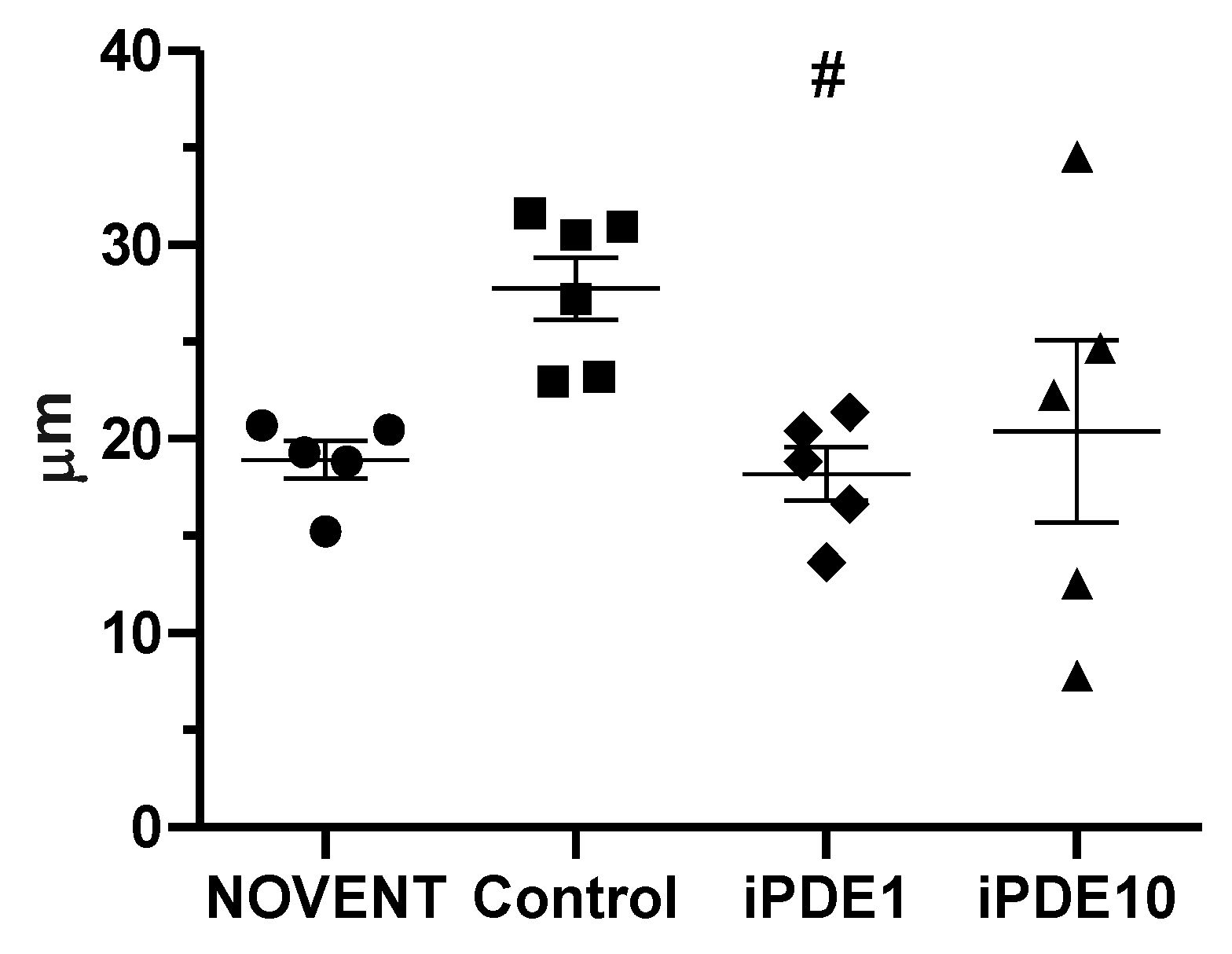


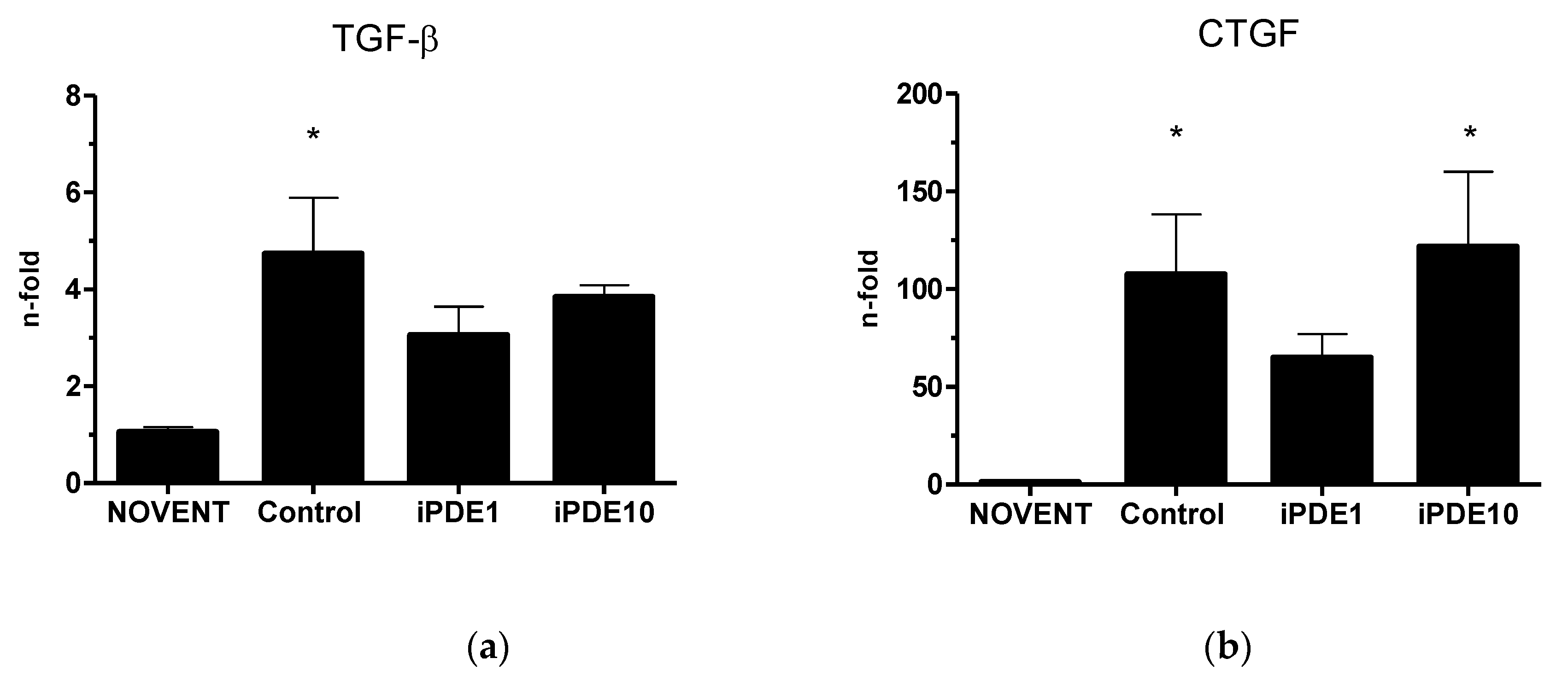
| NOVENT | Control | iPDE1 | iPDE10 | |
|---|---|---|---|---|
| VArch (air, lung) [cm3] | 46.1 ± 8.8 | 47.9 ± 6.6 | 37.2 ± 9.4 | 39.1 ± 13.6 |
| VArch(tissue, lung) [cm3] | 6.52 ± 2.06 | 11.79 ± 1.63 | 8.53 ± 2.49 | 9.23 ± 2.11 |
| SArch(alv, lung) [m2] | 4.8 ± 1.0 | 3.6 ± 0.9 | 3.0 ± 0.8 | 2.9 ± 0.7 |
| VCav (air, lung) [cm3] | 44.4 ± 7.9 | 45.2 ± 5.9 | 34.6 ± 8.3 | 38.0 ± 12.4 |
| VCav(tissue, lung) [cm3] | 6.26 ± 1.93 | 11.09 ± 1.40 | 7.89 ± 2.13 | 9.05 ± 1.91 |
| SCav(alv, lung) [m2] | 4.7 ± 1.0 | 3.4 ± 0.8 | 2.8 ± 0.6 | 2.9 ± 0.6 |
| Vv(non-cNP/lung) | 0.98 ± 0.00 | 0.98 ± 0.01 | 0.99 ± 0.01 | 0.97 ± 0.01 |
| Vv(cNP/lung) | 0.02 ± 0.00 | 0.02 ± 0.01 | 0.01 ± 0.01 | 0.03 ± 0.01 |
| Vv(fNP/non-cNP) | 0.12 ± 0.02 | 0.13 ± 0.02 | 0.25 ± 0.06 | 0.24 ± 0.03 |
| Vv(air/par) | 0.88 ± 0.02 | 0.80 ± 0.01 | 0.81 ± 0.04 | 0.80 ± 0.03 |
| Vv(tissue/par) | 0.12 ± 0.02 | 0.20 ± 0.01 | 0.19 ± 0.04 | 0.20 * ± 0.03 |
| Sv(alv/par) [cm−1] | 909.7 ± 29.1 | 615.5 * ± 36.1 | 661.1 * ± 69.4 | 639.6 * ± 57.1 |
| Vv(air/lung) | 0.77 ± 0.03 | 0.68 ± 0.02 | 0.60 ± 0.05 | 0.59 ± 0.05 |
| Vv(tissue/lung) | 0.10 ± 0.02 | 0.17 ± 0.01 | 0.14 ± 0.04 | 0.15 ± 0.02 |
| Sv(alv/lung) [cm−1] | 789.1 ± 26.4 | 521.5 * ± 28.1 | 492.5 * ± 75.4 | 468.7 * ± 21.5 |
| Lm(air) [µm] | 39.0 ± 2.2 | 53.1 ± 3.6 | 50.6 ± 6.9 | 50.8 ± 6.2 |
| t(tissue) [µm] | 2.5 ± 0.4 | 6.6 * ± 0.5 | 5.6 * ± 0.5 | 6.4 * ± 0.4 |
Disclaimer/Publisher’s Note: The statements, opinions and data contained in all publications are solely those of the individual author(s) and contributor(s) and not of MDPI and/or the editor(s). MDPI and/or the editor(s) disclaim responsibility for any injury to people or property resulting from any ideas, methods, instructions or products referred to in the content. |
© 2022 by the authors. Licensee MDPI, Basel, Switzerland. This article is an open access article distributed under the terms and conditions of the Creative Commons Attribution (CC BY) license (https://creativecommons.org/licenses/by/4.0/).
Share and Cite
Hütten, M.C.; Brokken, T.; Widowski, H.; Monaco, T.; Schneider, J.P.; Fehrholz, M.; Ophelders, D.; Kramer, B.W.; Kunzmann, S. Acute Lung Functional and Airway Remodeling Effects of an Inhaled Highly Selective Phosphodiesterase 4 Inhibitor in Ventilated Preterm Lambs Exposed to Chorioamnionitis. Pharmaceuticals 2023, 16, 29. https://doi.org/10.3390/ph16010029
Hütten MC, Brokken T, Widowski H, Monaco T, Schneider JP, Fehrholz M, Ophelders D, Kramer BW, Kunzmann S. Acute Lung Functional and Airway Remodeling Effects of an Inhaled Highly Selective Phosphodiesterase 4 Inhibitor in Ventilated Preterm Lambs Exposed to Chorioamnionitis. Pharmaceuticals. 2023; 16(1):29. https://doi.org/10.3390/ph16010029
Chicago/Turabian StyleHütten, Matthias Christian, Tim Brokken, Helene Widowski, Tobias Monaco, Jan Philipp Schneider, Markus Fehrholz, Daan Ophelders, Boris W. Kramer, and Steffen Kunzmann. 2023. "Acute Lung Functional and Airway Remodeling Effects of an Inhaled Highly Selective Phosphodiesterase 4 Inhibitor in Ventilated Preterm Lambs Exposed to Chorioamnionitis" Pharmaceuticals 16, no. 1: 29. https://doi.org/10.3390/ph16010029
APA StyleHütten, M. C., Brokken, T., Widowski, H., Monaco, T., Schneider, J. P., Fehrholz, M., Ophelders, D., Kramer, B. W., & Kunzmann, S. (2023). Acute Lung Functional and Airway Remodeling Effects of an Inhaled Highly Selective Phosphodiesterase 4 Inhibitor in Ventilated Preterm Lambs Exposed to Chorioamnionitis. Pharmaceuticals, 16(1), 29. https://doi.org/10.3390/ph16010029





